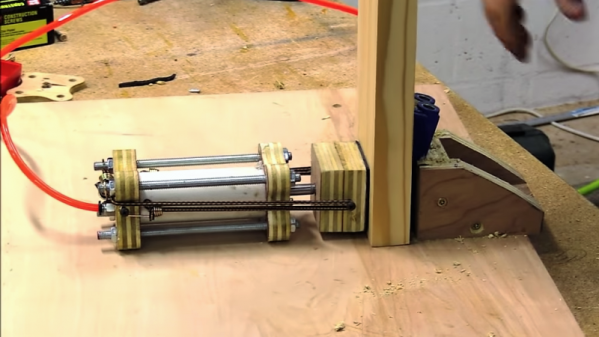Off-the-shelf stock parts are the blocks from which we build mechanical projects. And while plenty of parts have dedicated uses, I enjoy reusing them in ways that challenge what they were originally meant for while respecting the constraints of their construction. Building off of my piece from last time, I’d like to add to your mechanical hacking palette with four more ways we can re-use some familiar off-the-shelf parts. Continue reading “The BSides: More Curious Uses Of Off-the-shelf Parts”
O-ring6 Articles
Rubber Bands And O-Rings Give 3D Prints Some Stretch
Sometimes it would be helpful if a 3D printed object could stretch & bend. Flexible filament like TPU is one option, but [NagyBig] designed a simple bracelet to ask: how about embedding rubber bands or o-rings into the print itself?
Embedding objects into prints usually involves hardware like fasteners or magnets, but this is the first one (we can think of) that uses rubber bands. Though we have seen rubber bracelets running on printed wheels, and o-rings used to provide tension on a tool holder.
The end result is slightly reminiscent of embedding 3D printed shapes into tulle in order to create fantastic, armor-like flexible creations. But using rubber bands means the result is stretchy and compliant to a degree we haven’t previously seen. Keep it in mind the next time you’re trying to solve a tricky design problem; an embedded o-ring or rubber band might just do the trick.
Continue reading “Rubber Bands And O-Rings Give 3D Prints Some Stretch”
Clacker Hacker: Hot Rod Switch Mods
Whether you’re a programmer, gamer, writer, or data entry specialist, the keyboard is an extension of your nervous system. It’s not so much a tool as it is a medium for flow — for being in the zone. So I think it’s only natural that you should care deeply about your keyboard — how it looks, how it sounds, and above all, how it feels to finger-punch those helmeted little switches all the live-long day. That’s my excuse, anyway.
It might surprise you that mechanical keyboard switches can be modified in a number of ways. Depending on what you want from your keyboarding experience, you can make switches feel lighter or less scratchy, quiet them down, or tighten up any wobble in the housing. Why would you want to do this? Because customization is fun. Because electromechanical things are awesome, and because it’s fun to take switches apart and put them back together again. Because it’s literally hacking and this is Hackaday.

I got into switch modding because I wanted to put Cherry clears in my dactyl, but worried that they would take too much force to actuate and wear my fingers out. So I bought some really light (39g) springs and was really looking forward to swapping them into the clears, but they just don’t work. Like, physically. Slider goes down, slider gets stuck. It will come back up, but only if I hit it again and smear my finger to the side a bit at the same time. Those springs must be too weak to return clear sliders.
I took this as a sign that I should suck it up and use browns instead. After all, no one else has to know what my sliders look like. While I was opening switches, I tried out one of these super-light springs in a brown, thinking maybe they wouldn’t have to go to waste. Not only did the lighter spring work in the brown, it felt pretty nice. It’s hard to imagine how a whole keeb would feel based on a single switch, but if you can gather a handful and snap them into a plate to riffle your fingers over them, well, it’s probably close enough to a full keyboard to get a good feel for whatever mod you’re doing.
Hackaday Links: March 22, 2020
Within the span of just two months, our world of unimaginable plenty and ready access to goods manufactured across the globe has been transformed into one where the bare essentials of life are hard to find at any price. The people on the frontline of the battle against COVID-19 are suffering supply chain pinches too, often at great risk to their health. Lack of proper personal protective equipment (PPE), especially face masks, is an acute problem, and the shortage will only exacerbate the problem as healthcare workers go down for the count. Factories are gearing up to make more masks, but in the meantime, the maker and hacker community can pitch in. FreeSewing, an open-source repository of sewing patterns, has a pattern for a simple face mask called the Fu that can be made quickly by an experienced threadworker. Efficacy of the masks made with that pattern will vary based on the materials used, obviously; a slightly less ad hoc effort is the 100 Million Mask Challenge, where volunteers are given a pattern and enough lab-tested materials to make 100 face masks. If you know how to sew, getting involved might make a difference.
As people around the world wrap their heads around the new normal of social distancing and the loss of human contact, there’s been an understandable spike in interest in amateur radio. QRZ.com reports that the FCC has recorded an uptick in the number of amateur radio licenses issued since the COVID-19 outbreak, and license test prep site HamRadioPrep.com has been swamped by new users seeking to prepare for taking the test. As we’ve discussed, the barrier for entry to ham radio is normally very low, both in terms of getting your license and getting the minimal equipment needed to get on the air. One hurdle aspiring hams might face is the cancellation of so-called VE testing, where Volunteer Examiners administer the written tests needed for each license class. Finding a face-to-face VE testing session now might be hard, but the VEs are likely to find a way to adapt. After all, hams were social distancing before social distancing was cool.
The list of public events that have been postponed or outright canceled by this pandemic is long indeed, with pretty much everything expected to draw more than a handful of people put into limbo. The hacking world is not immune, of course, with many high-profile events scuttled. But we hackers are a resourceful bunch, and the 10th annual Open Source Hardware Summit managed to go off on schedule as a virtual meeting last week. You can watch the nearly eight-hour livestream while you’re self-isolating. We’re confident that other conferences will go virtual in the near-term too rather than cancel outright.
And finally, if you’re sick of pandemic news and just want some escapist engineering eye candy, you could do worse than checking out what it takes to make a DSLR camera waterproof. We’ve honestly always numbered cameras as among the very least waterproof devices, but it turns out that photojournalists and filmmakers are pretty rough on their gear and expect it to keep working even so. The story here focuses (sorry) on Olympus cameras and lenses, which you’ll note that Takasu-san only ever refers to as “splash-proof”, and the complex system of O-rings and seals needed to keep water away from their innards. For our money, the best part was learning that lenses that have to change their internal volume, like zoom lenses, need to be vented so that air can move in and out. The engineering needed to keep water out of a vented system like that is pretty impressive.
Printed It: Parametric Hex Key Holder
Desktop 3D printing is an incredible technology to be sure, but it’s not a cure-all. If you’re interested in making something in large numbers, or if production speed is a concern, 3D printing probably isn’t what you’re looking for. But on the flip side, if you want to make a few highly specialized or customized objects, desktop 3D printing represents an absolute revolution in capability for the individual hacker and maker.
In our ongoing mission to prove that desktop 3D printing isn’t just a novelty, we keep a close eye out for printable objects which play to the strengths of the technology. You won’t find any benchmarks or dust collectors here; everything featured in Printed It is a bona fide practical object. An ideal entry into this series is something that you wouldn’t need to print more than a few times, isn’t easily sourced or made via traditional means, and if possible, offers some form of customization which makes it more suitable to the individual’s needs than what’s commercially available.
Not every object we feature hits all of these marks, but this parametric hex key holder designed by [Daniel Leitner] absolutely does. This object was created to address a problem that we imagine most Hackaday readers share: taming an ever-growing collection of hex keys. What’s more, this design is something of an open source success story. It’s an idea that passed through the hands of multiple community members, becoming more refined and functional as it went. Even if you don’t personally need to wrangle some unruly hex keys, this object is a fascinating look at how 3D printing and the community that has sprouted up around it is truly evolving the process of going from concept to execution.
Shop-Made Pneumatic Cylinders From PVC And Plywood
You see a lot of pneumatic actuators in industrial automation, and for good reason. They’re simple, powerful, reliable, and above all, cheap. Online sources and fluid-power suppliers carry a bewildering range of actuators, so why would anyone bother to make their own pneumatic cylinders? Because while the commercial stuff is cheap, it’s not PVC and plywood cheap.
Granted, that’s not the only reason [Izzy Swan] gives for his DIY single-acting cylinder. For him it’s more about having the flexibility to make exactly what he needs in terms of size and shape. And given how ridiculously easy these cylinders are, you can make a ton of them for pennies. The cylinder itself is common Schedule 40 PVC pipe with plywood endcaps, all held together with threaded rod. [Izzy] cut the endcaps with a CNC router, but a band saw or jig saw would do as well. The piston is a plywood plug mounted to a long bolt; [Izzy] gambled a little by cutting the groove for the O-ring with a table saw, but no fingers were lost. The cylinder uses a cheap bungee as a return spring, but an internal compression spring would work too,. Adding a second air inlet to make the cylinder double-acting would be possible as well. The video below shows the cylinder in action as a jig clamp.
True, the valves are the most expensive part of a pneumatic system, but if nothing else, being able to say you made your own cylinders is a win. And maybe you’ll get the fluid-power bug and want to work up to DIY hydraulics.
Continue reading “Shop-Made Pneumatic Cylinders From PVC And Plywood”
















